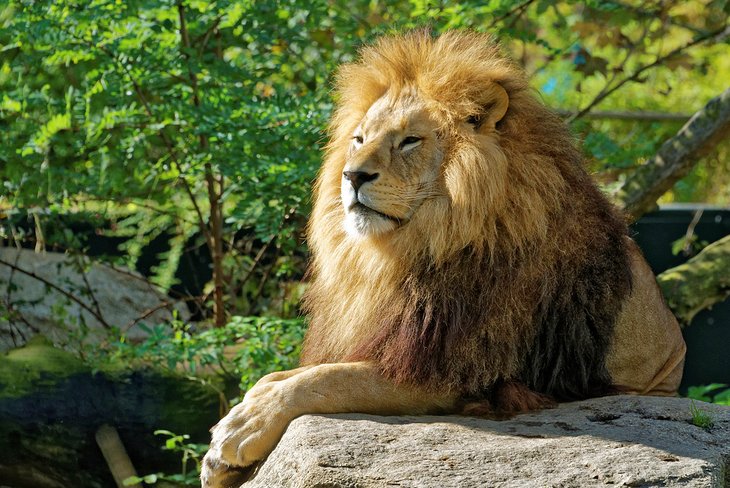
by Best-Mag Magazine Editorial | Travel
Munich , Bavaria’s capital, is home to centuries-old buildings and numerous museums. The city is known for its annual Oktoberfest celebration and its beer halls, including the famed Hofbräuhaus, founded in 1589. In the Altstadt (Old Town), central Marienplatz square contains landmarks such as Neo-Gothic Neues Rathaus (town hall), with a popular glockenspiel show that chimes and reenacts stories from the 16th century.
Today, Munich is a global centre of art, science, technology, finance, publishing, culture, innovation, education, business, and tourism and enjoys a very high standard and quality of living, reaching first in Germany and third worldwide according to the 2018 Mercer survey, and being rated the world’s most liveable city by the Monocle’s Quality of Life Survey 2018. Munich is consistently ranked as one of the most expensive cities in Germany in terms of real estate prices and rental costs. According to the Globalization and World Rankings ResearchToday, Munich is a global centre of art, science, technology, finance, publishing, culture, innovation, education, business, and tourism and enjoys a very high standard and quality of living, reaching first in Germany and third worldwide according to the 2018 Mercer survey, and being rated the world’s most liveable city by the Monocle’s Quality of Life Survey 2018. Munich is consistently ranked as one of the most expensive cities in Germany in terms of real estate prices and rental costs. According to the Globalization and World Rankings Researc Institute, Munich is considered an alpha-world city, as of 2015. It is one of the most prosperous and fastest growing cities in Germany. The city is home to more than 530,000 people of foreign background, making up 37.7% of its population.
Munich’s economy is based on high tech, automobiles, the service sector and creative industries, as well as IT, biotechnology, engineering and electronics among many other sectors. It has one of the strongest economies of any German city and the lowest unemployment rate of all cities in Germany with more than 1 million inhabitants. Munich is also one of the most attractive business locations in Germany. The city houses many multinational companies, such as BMW, Siemens, MAN, Allianz and MunichRE. In addition, Munich is home to two research universities, a multitude of scientific institutions, and world-renowned technology and science museums like the Deutsches Museum and BMW Museum. Munich’s numerous architectural and cultural attractions, sports events, exhibitions and its annual Oktoberfest, the world’s largest Volksfest, attract considerable tourism.
1.Marienplatz and the Neues Rathaus
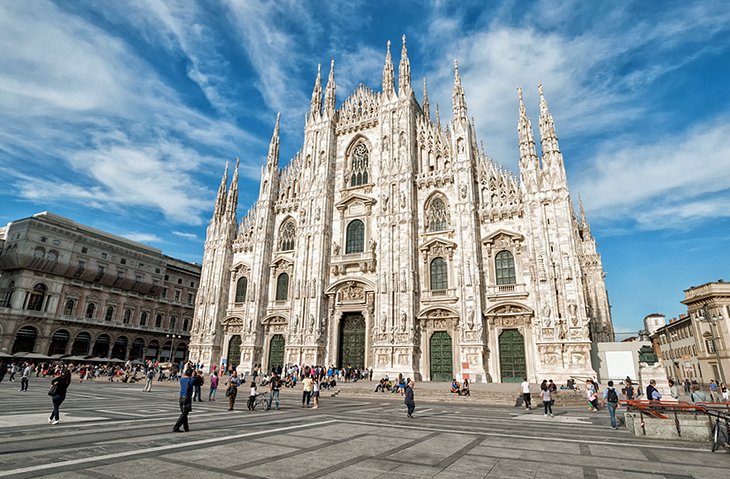
The New Town Hall is a town hall at the northern part of Marienplatz in Munich, Bavaria, Germany. It hosts the city government including the city council, offices of the mayors and a small portion of the administration. In 1874 the municipality had left the Old Town Hall for its new domicile.
Marienplatz has been Munich’s central square since the city’s foundation; the site of medieval jousting tournaments; and until 1807, where markets were held. In addition to the massive Neues Rathaus (New City Hall) that fills one entire side of the square, you’ll find the Altes Rathaus (Old Town Hall) forming a gate at the far end.
In the large open square are the Mariensäule, a tall column to the Virgin Mary erected in 1638, and the Fischbrunnen, a newer fountain that includes bronze figures rescued from an earlier 19th-century fountain. Popular with shoppers for its stores, boutiques, and restaurants, Marienplatz is the focus of festivals and scene of a large Christmas Market, one of several in the city. During the Fasching carnival, the Narren-Lindwurm (dragon) dances over the square.
The decision to construct a new building came due to the lack of space in the Old Town Hall and the adjoining, so-called “Lesser Town Hall” on Petersbergl (destroyed in 1944, not reconstructed). In memory of the bourgeois high season during the Gothic period, the choice fell upon a neo-Gothic design, which allowed an implement an independent architectural accent in contrast to the buildings of the royal family.
2.Nymphenburg Palace and Gardens
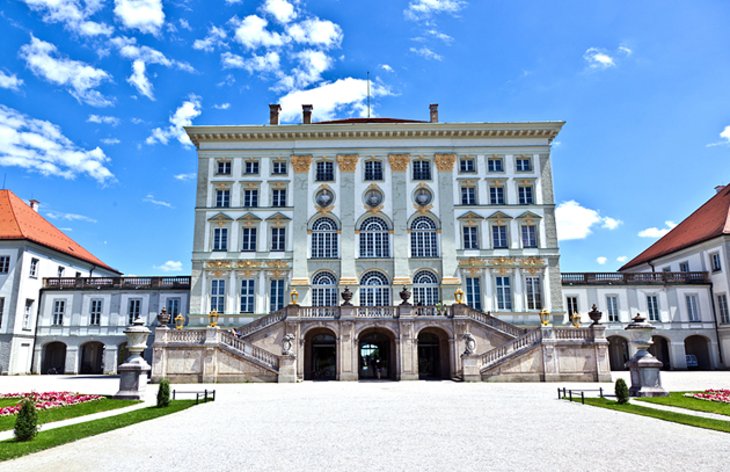
The large Baroque palace of Nymphenburg, in the northwest outskirts of the city, was originally the summer residence of the Wittelsbach Electors in the 17th century. Extending more than 600 meters from wing to wing, this vast palace is surrounded on each side by the Nymphenburg Canal, which splits as it passes around the main buildings before reuniting again in a fountain-adorned pool in front of the main façade.
Your first stop should be the Central Pavilion, a cube-shaped palace in the style of an Italian villa, completed in 1674 and home to the lavishly decorated three-story Stone Hall (Steinerner Saal) and a number of private chambers with fine furnishings and artwork. In the Palace Chapel, notice the expressive ceiling painting illustrating the life of Mary Magdalene. Beside the palace in the former Court Stables, the Marstallmuseum displays a collection of beautiful state coaches.
The exquisite composition of formal garden elements and English-style country park is considered a masterpiece of garden design and the spacious complex of palace and park has always been a popular attraction for local residents and tourists alike. To the east the park adjoins the palace buildings and the Grand circle. To the south and west the park is largely enclosed by the original Garden wall and borders the Botanical Garden to the north and beyond Menzinger Straße the park peripherie partly merges with the Kapuzinerhölzl forest.
The designs of the original Baroque gardens had largely been modeled on the French gardens at Vaux-le-Vicomte and Versailles. The modern park layout is the result of a fundamental redesign by Friedrich Ludwig Sckell, beginning in 1799. The park area within the Garden wall occupies 180 hectares and the complete complex covers 229 hectares.
3.Munich Residenz
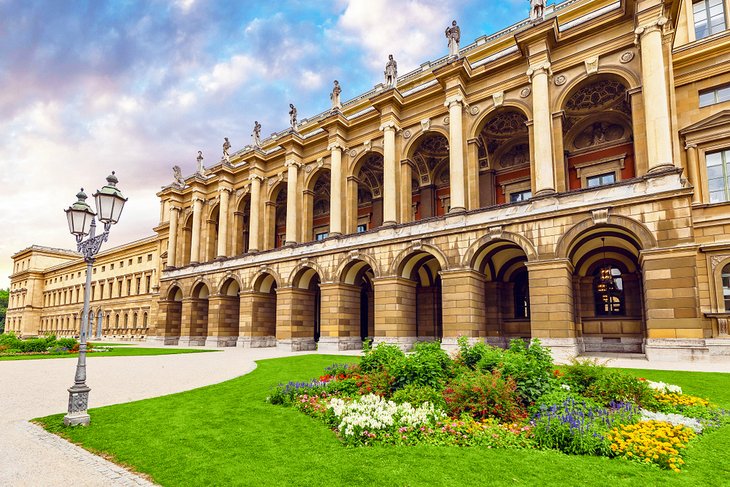
The Residenz in central Munich is the former royal palace of the Wittelsbach monarchs of Bavaria. The Residenz is the largest city palace in Germany and is today open to visitors for its architecture, room decorations, and displays from the former royal collections.
The complex of buildings contains ten courtyards and displays 130 rooms. The three main parts are the Königsbau (near the Max-Joseph-Platz), the Alte Residenz (Old Residenz; towards the Residenzstraße) and the Festsaalbau (towards the Hofgarten). A wing of the Festsaalbau contains the Cuvilliés Theatre since the reconstruction of the Residenz after World War II. It also houses the Herkulessaal (Hercules Hall), the primary concert venue for the Bavarian Radio Symphony Orchestra. The Byzantine Court Church of All Saints (Allerheiligen-Hofkirche) at the east side is facing the Marstall, the building for the former Court Riding School and the royal stables.
For centuries the seat of the dukes, electors, and kings of Bavaria, the Munich Residenz is one of Europe’s most spectacular palaces. Laid out around seven large courts, the vast Residenz complex comprises three main sections: the Königsbau, fronting onto Max-Joseph-Platz; the Alte Residenz, facing Residenzstrasse; and the Festsaalbau (Banqueting Hall), overlooking the Hofgarten.
The earliest section of this huge complex was the magnificent Antiquarium, built in 1579 and now part of the outstanding Residenz Museum. The Alte Residenz, a masterpiece of the late Renaissance and testimony to the growing power of Bavaria, followed soon after, and the final components – the Neoclassical Königsbau, the Festsaalbau, and the Court Church – were completed in 1848.
4.BMW Museum
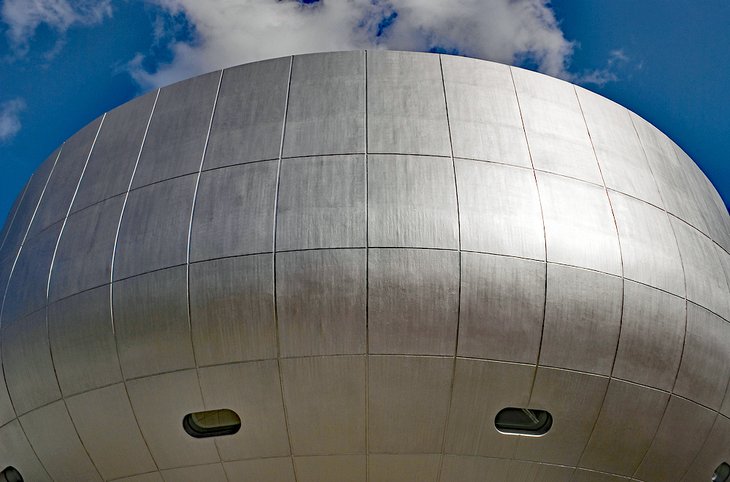
The BMW Museum is an automobile museum of BMW history located near the Olympiapark in Munich, Germany. The museum was established in 1973, shortly after the Summer Olympics opened. From 2004 to 2008, it was renovated in connection with the construction of the BMW Welt, directly opposite. The museum reopened on 21 June 2008. At the moment the exhibition space is 5,000 square metres for the presentation of about 120 exhibits.
Next to BMW’s soaring headquarters and factories at the Olympic Park is a round contemporary building with a metal shell, housing BMW’s museum. Here, car fans will find examples of nearly all the models the company has made, including sports cars, racing models, and motorcycles.
You can see current models and learn about the technology of modern automobile construction, as well as get glimpses of future propulsion technologies and designs the company is exploring. Those who think cars are just for getting from point A to point B might want to skip this one, but for fans of things automotive, it’s a must.
5.Viktualien markt
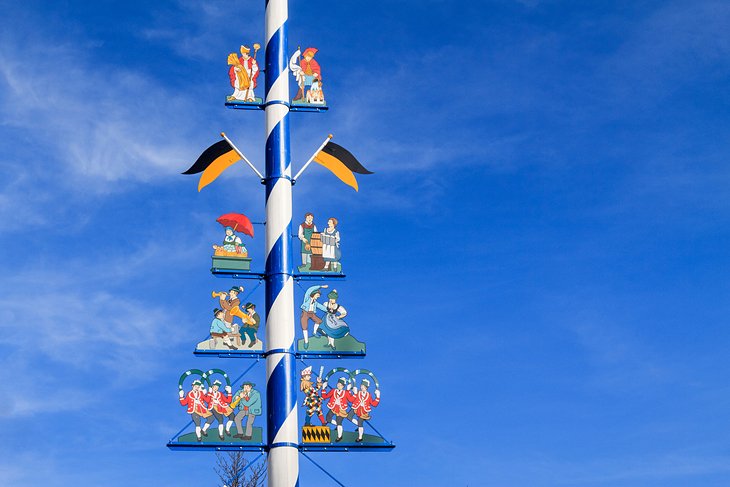
The Viktualienmarkt is a daily food market and a square in the center of Munich, Germany. It has been held daily since 1807, except on Sundays and public holidays. The Viktualienmarkt developed from an original farmers’ market to a popular market for gourmets.
De Viktualienmarkt is een permanente markt voor levensmiddelen in het centrum van de Duitse stad München. Sinds 1807 vindt hij dagelijks – met uitzondering van zon- en feestdagen – plaats.
Het meer dan twee hectare grote plein omvat meerdere vaste standplaatsen met soms uitgebreide uitstallingen. Daarbij komen de seizoensgebonden losse kramen. Dit alles geschikt in meerdere afdelingen rond een centrale biergarten. Op het plein vindt men ook de meiboom van München en meerdere fonteinen. Aan de noordzijde bevinden zich de Heilige Geestkerk en de “Alte Peter”.
In 1807, when the farmers market outgrew Marienplatz, it was moved to the nearby square, where it thrived and expanded, until today it covers 22,000 square meters and includes a butchers’ hall, bakery, fish hall, and flower market in addition to its fruit and vegetable vendors.
It’s not just a place for locals to buy items for the night’s dinner. Fresh breads and pastries, wheels of cheese, and cured meats are good picnic makings, and tables and benches provide a place for shoppers and visitors to sit while they eat sizzling sausages, hot pretzels, and other foods prepared in mobile kitchens.
6.Tierpark Hellabrunn (Hellabrunn Zoo)

Hellabrunn Zoo (German: Tierpark Hellabrunn) is a 40 hectare (99 acre) zoological garden in the Bavarian capital of Munich. The zoo is situated on the right bank of the river Isar, in the southern part of Munich near the quarter of Thalkirchen.
A high ratio of enclosures are cageless, relying upon moat features to keep the animals in place. The zoo was the first zoo in the world not organized by species, but also by geographical aspects. For example, the wood bison share their enclosure with prairie dogs.
In 2013, the zoo was ranked the fourth best zoo in Europe (up from 12th). It focuses on conservation and captive breeding rare species such as the rare drill and silvery gibbons. Also gorillas, giraffes, elephants, wood bisons, elk and Arctic foxes were successfully bred in the zoo, which houses many species. It is one of the very few zoos that allows visitors to bring dogs.
Tierpark Hellabrunn is a member of the European Association of Zoos and Aquaria (EAZA) and the World Association of Zoos and Aquariums (WAZA) and participates in the European Endangered Species Programme (EEP).
Spread across 89 acres, Hellabrunn Zoo is consistently ranked among the best zoos in Europe. Laid out in 1911, it was the first zoo in the world to have animals grouped according to where they came from.
Today, more than 19,000 animals from 757 species are held in open enclosures meant to replicate the conditions of the wild, with animals that normally share habitats kept together wherever possible.
Popular features include the Elephant House (now a listed building), the enormous 5,000-square-meter free-flight aviary, the Polarium, and ape houses. Located adjacent to the Isar River in a designated conservation area, the zoo has many delightful footpaths, playgrounds, and picnic spots.
7.Peterskirche (St. Peter’s Church)
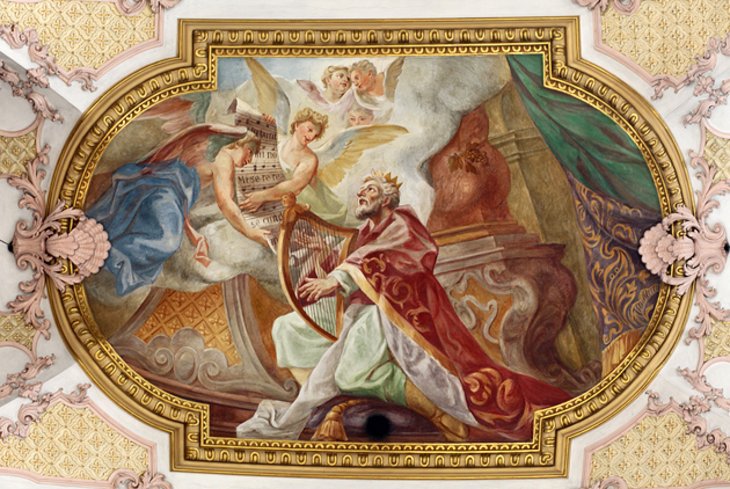
St. Peter’s Church is a Roman Catholic parish church in the inner city of Munich, southern Germany. Its 91-metre (299 ft) tower is commonly known as “Alter Peter”—Old Peter—and is emblematic of Munich. St Peter’s is the oldest recorded parish church in Munich and presumably the originating point for the whole city.
Known affectionately as Old Peter, St. Peter’s Church (Peterskirche) is Munich’s oldest parish church and stands on Petersberg, a small hill originally settled by monks. Built in Gothic style in 1386, the church was altered with the addition of a Baroque choir with three apses in 1636, while the tower was given a lantern dome in place of its earlier Gothic spires.
Interior highlights include the font by Hans Krumper, the red marble monuments by Erasmus Grasser, and the 15th-century Schrenk Altar with its sculptures of the Crucifixion and the Last Judgment. Also of note is the 20-meter-tall 18th-century high altar with its figures of the Four Fathers of the Church and St. Peter.
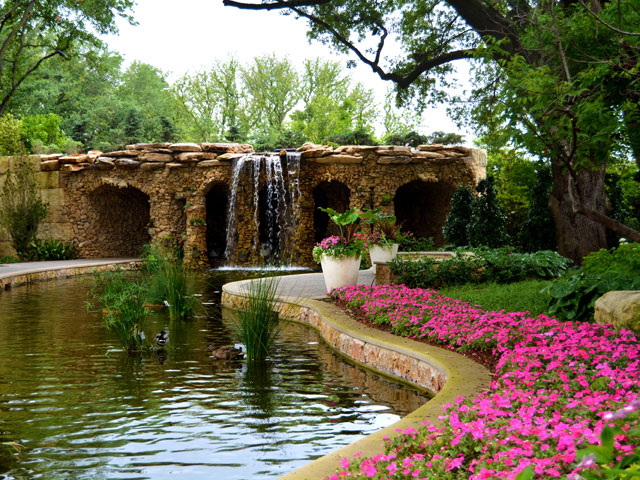
by Best-Mag Magazine Editorial | Travel
Texas is a state in the South Central region of the United States. At 268,596 square miles, and with more than 30 million residents in 2022, it is the second-largest U.S. state by both area and population.
Houston is the most populous city in Texas and the fourth-largest in the U.S., while San Antonio is the second most populous in the state and seventh-largest in the U.S. Dallas–Fort Worth and Greater Houston are, respectively, the fourth- and fifth-largest metropolitan statistical areas in the country. Other major cities include Austin, the second most populous state capital in the U.S., and El Paso. Texas is nicknamed the Lone Star State for its former status as an independent republic, and as a reminder of the state’s struggle for independence from Mexico. The Lone Star can be found on the Texas state flag and on the Texas state seal.The origin of Texas’s name is from the Caddo word táyshaʼ meaning ‘friends’.
Due to its size and geologic features such as the Balcones Fault, Texas contains diverse landscapes common to both the U.S. Southern and the Southwestern regions.Although Texas is popularly associated with the U.S. southwestern deserts, less than ten percent of Texas’s land area is desert. Most of the population centers are in areas of former prairies, grasslands, forests, and the coastline. Traveling from east to west, one can observe terrain that ranges from coastal swamps and piney woods, to rolling plains and rugged hills, and finally the desert and mountains of the Big Bend.
The term “six flags over Texas” refers to several nations that have ruled over the territory.Spain was the first Europea.
1.San Antonio’s River
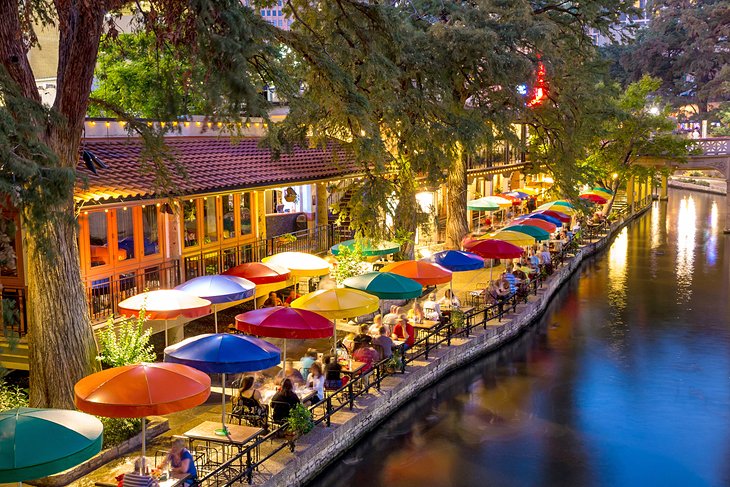
Stretching for several miles along the San Antonio River in the heart of the city, the River Walk is lined with restaurants and lovely outdoor patios, where you can sit and dine alongside the river. Built below street level, this pedestrian walkway hugs the river as it winds and weaves through the city, and is as popular among locals as it is for tourists, day and night.
Although strolling along the river is the most popular thing to do here, another great way to enjoy the ambience of the area is on a leisurely cruise on a river boat. These run all the time and range from standard sightseeing trips to dinner cruises.
During the Texas Revolution, the river was host to several major conflicts. The Battle of Concepcion occurred when the Mexican forces in Bexar and Texian militia fired upon each other in a small skirmish on the mission’s grounds. The Grass Fight occurred when Texian militia mistook mules carrying grass to feed horses as mules carrying supply and gold money. The siege of Bexar was the climax of all these previous events when the Texian militia surrounded Bexar and began continuous attacks into the Mexican stronghold of Bexar until the Mexican General Martín Perfecto de Cos surrendered.
2.The Alamo

The Alamo is a historic Spanish mission and fortress compound founded in the 18th century by Roman Catholic missionaries in what is now San Antonio, Texas, United States.
De Slag om de Alamo, meestal kortweg De Alamo genoemd, is een belegering tijdens de Texaanse Onafhankelijkheidsoorlog (1836). De Alamo was een katholiek missiegebouw in San Antonio, het centrum van de Texaanse Onafhankelijkheidsbeweging. De Texaanse Onafhankelijkheidsoorlog was een militair conflict tussen Mexico en rebellen die voor onafhankelijkheid van Texas vochten, destijds onderdeel van de Mexicaanse staat Coahuila y Texas. De oorlog eindigde met de onafhankelijkheid van de Republiek Texas.
Op 23 februari 1836 overviel de Mexicaanse generaal Antonio López de Santa Anna met 1600 soldaten het stadsgarnizoen waar 180 tot 200 Texaanse strijders waren gelegerd, onder wie ook de kolonisten Davy Crockett en Jim Bowie. De beperkte groep Texanen trok zich terug in de Alamo. Ze zouden zich niet overgeven en de belegering zou tot 6 maart duren. De Texanen geraakten zonder munitie en werden daarop door de Mexicanen bestormd. Alle mannen werden gedood.
The Alamo is one of the most important historic sites in America. Part of a mission station established in 1718, it was built by Franciscans in 1744 and by 1836, had been converted into a fort. It became famous during the Texas Revolution, when a small force, including Davie Crockett and James Bowie, barricaded themselves in against an overwhelmingly superior Mexican army some 3,000 strong. While the defeat saw all 187 defenders killed, the cry of “Remember the Alamo!” rallied the state to eventually overcome the Mexicans.
Today, you can visit this landmark to see its restored buildings and the cenotaph commemorating the fallen Texans. Inside is a museum with changing displays, featuring weapons and artifacts related to the events and the history of the mission.
3.Space Center Houston
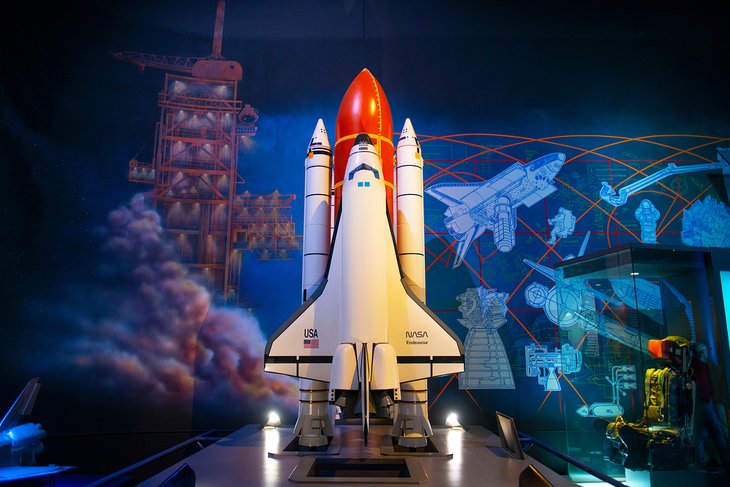
Space Center Houston is a science museum that serves as the official visitor center of NASA Johnson Space Center in Houston. It was designated a Smithsonian Affiliate museum in 2014.
Just 30 minutes’ drive from the heart of Houston, Space Center Houston is one of the most popular tourist attractions in Texas. This is a wonderful place to learn about space exploration, upcoming missions, NASA’s latest projects, and possibly even meet an astronaut. Space Center Houston is also home to Johnson Space Center and Mission Control, which can be visited on a tour.
Plan to spend at least a half-day exploring the entire complex, which includes a space shuttle replica mounted on a shuttle carrier. Visitors can walk inside the shuttle and the carrier. You can also walk inside a replica of America’s first space station, Skylab. Other highlights include seeing rockets and touching a rock from the moon and Mars.
The center opened in 1992 replacing the former Visitor Center in Johnson Space Center Building 2. The museum is 250,000 square feet (23,000 m2) and displays over 400 space artifacts, including the Mercury 9, Gemini 5, and Apollo 17 space capsules.
4.Big Bend National Park

Big Bend National Park is in southwest Texas and includes the entire Chisos mountain range and a large swath of the Chihuahuan Desert. The Ross Maxwell Scenic Drive leads to the ruins of Sam Nail Ranch, now home to desert wildlife. The Santa Elena Canyon, carved by the Rio Grande, features steep limestone cliffs. Langford Hot Springs, near the Mexican border, has pictographs and the foundations of an old bathhouse.
In the Chihuahuan Desert of West Texas, on a huge bend in the Rio Grande River, lies some of the most dramatic and uniquely beautiful scenery in the state. Mountains, canyons, and the river flowing along the border, separating the United States from Mexico, offer a diverse range of recreational and sightseeing opportunities for visitors to Big Bend National Park.
While most people simply enjoy touring along the roads, the park offers a full range of things to do. Outdoor enthusiasts will enjoy the extensive network of hiking trails and the beautiful campgrounds. Paddling along the Rio Grande or enjoying a picnic and wading into the water are other popular activities on warm days.
The area has a rich cultural history, from archeological sites dating back nearly 10,000 years to more recent pioneers, ranchers, and miners.The Chisos Mountains are located in the park, and are the only mountain range in the United States to be fully contained within the boundary of a national park. Geological features in the park include sea fossils and dinosaur bones, as well as volcanic dikes.
The park encompasses an area of 801,163 acres (1,251.8 sq mi; 3,242.2 km2), entirely within Brewster County.For more than 1,000 miles (1,600 km), the Rio Grande/Río Bravo forms the boundary between Mexico and the United States, and Big Bend National Park administers approximately 118 miles (190 km) along that boundary.
Because the Rio Grande serves as an international boundary, the park faces unusual constraints while administering and enforcing park rules, regulations, and policies. In accordance with the Treaty of Guadalupe Hidalgo, the park’s territory extends only to the center of the deepest river channel as the river flowed in 1848. The rest of the channel and the land south of it lies within Mexican territory. The park is bordered by the protected areas of Cañón de Santa Elena and Maderas del Carmen in Mexico.
5.Padre Island National Seashore
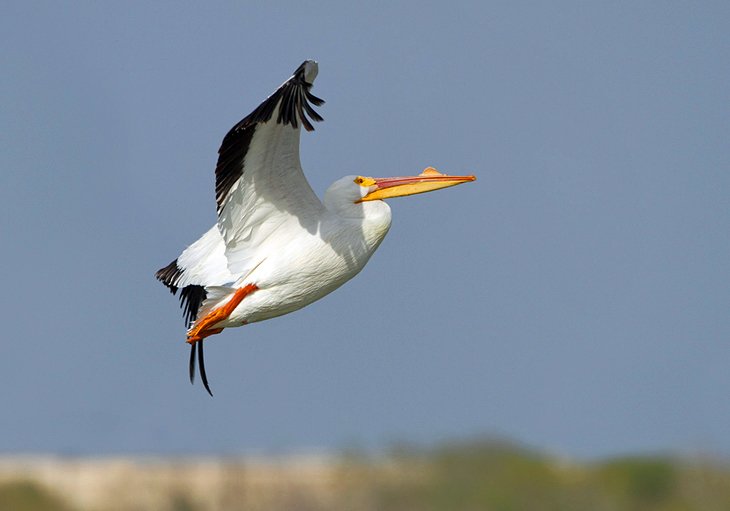
Padre Island National Seashore is a national seashore located on Padre Island off the coast of South Texas. In contrast to South Padre Island, known for its beaches and vacationing college students, PINS is located on North Padre Island and consists of a long beach where nature is preserved.
The world’s longest undeveloped barrier island, Padre Island is just a short drive south of Corpus Christi and stretches 70 miles from end-to-end. One of the most important conservation areas in Texas, Padre Island consists of more than 130,000 acres of beach, dunes, and grassland habitats, and is home to rare sea turtles and countless migratory birds, making it a birder’s paradise. In fact, 350 different species visit this stopover on the Central Flyway migratory route.
The Malaquite Visitor Center is the best place to begin your visit of this beautiful coastal region of the Gulf of Mexico. It provides plenty of information, as well as assistance for those with mobility issues, including specially adapted beach wheelchairs.
Most of the park is primitive, but camping is available, and most of the beach is only accessible to four-wheel-drive vehicles. All but four miles is open to vehicle traffic. PAIS is the fourth designated national seashore in the United States.
North Padre Island is the longest undeveloped barrier island in the world. The national seashore is 70 miles (110 km) long with 65.5 miles (105.4 km) of Gulf beach. PAIS hosts a variety of pristine beach, dune, and tidal flat environments, including the Laguna Madre on its west coast, a famous spot for windsurfing. It is located in parts of Kleberg, Kenedy, and Willacy counties, with Kenedy County having the majority of its land area.
6.The Texas State Capitol in Austin

The Texas State Capitol, built in 1888, is considered one of the finest state legislatures in the US. In Austin’s downtown core and now a National Historic Landmark, it certainly impresses with its dimensions, standing 308 feet tall.
Highlights of its 22-acre park include monuments to the defenders of the Alamo and to veterans of the Vietnam War. Guided tours of the building’s interior are available and start from the visitor center with its many displays. At dusk, head across to the Ann W. Richards Congress Avenue Bridge for a chance to witness the spectacle of a million or so Mexican free-tailed bats coming and going from their perches under the bridge
7.The Dallas Arboretum and Botanical Garden

The Arboretum opened in 1984 .The Dallas Arboretum and Botanical Garden is a 66-acre (27 ha) botanical garden located at 8525 Garland Road in East Dallas, Texas, on the southeastern shore of White Rock Lake.In September 2002, Arboretum facilities were expanded with the opening of the new visitors center, named after Dallas developer Trammell Crow. At night, one may view downtown Dallas with the skyscraper lights reflecting upon the water in A Tasteful Place, the 3-acre (1.2 ha) food and herb garden and cooking pavilion and kitchen.
There are 19 named gardens :
The Trammell Crow Visitor Education Pavilion and Entry Plaza
Margaret Elisabeth Jonsson Color Garden
A Woman’s Garden
The Nancy Rutchik Red Maple Rill
The Lyda Bunker Hunt Paseo de Flores
Boswell Family Garden
McCasland Sunken Garden
The Eugenia Leftwich Palmer Fern Dell
The Nancy Clements Seay Magnolia Glade
Nancy’s Garden
Crape Myrtle Allee
Chandler Lindsley Shadow Garden
Pecan Grove
The Martha Brooks Camellia Garden
DeGolyer Gardens
Lay Family Garden
Rose Mary Haggar Rose Garden
The Rory Meyers Children’s Adventure Garden

by Best-Mag Magazine Editorial | Travel
Berlin, Germany’s capital, dates to the 13th century. Reminders of the city’s turbulent 20th-century history include its Holocaust memorial and the Berlin Wall’s graffitied remains. Divided during the Cold War, its 18th-century Brandenburg Gate has become a symbol of reunification. The city’s also known for its art scene and modern landmarks like the gold-colored, swoop-roofed Berliner Philharmonie, built in 1963.
Berlin straddles the banks of the Spree, which flows into the Havel (a tributary of the Elbe) in the western borough of Spandau. Among the city’s main topographical features are the many lakes in the western and southeastern boroughs formed by the Spree, Havel and Dahme, the largest of which is Lake Müggelsee. Due to its location in the European Plain, Berlin is influenced by a temperate seasonal climate. About one-third of the city’s area is composed of forests, parks, gardens, rivers, canals, and lakes. The city lies in the Central German dialect area, the Berlin dialect being a variant of the Lusatian-New Marchian dialects.
Berlin is a world city of culture, politics, media and science. Its economy is based on high-tech firms and the service sector, encompassing a diverse range of creative industries, startup companies, research facilities, media corporations, and convention venues. Berlin serves as a continental hub for air and rail traffic and has a highly complex public transportation network. The metropolis is a popular tourist destination. Significant industries also include IT, healthcare, biomedical engineering, biotechnology, automotive, construction, electronics, social economy and clean tech.
1.The Brandenburg Gate
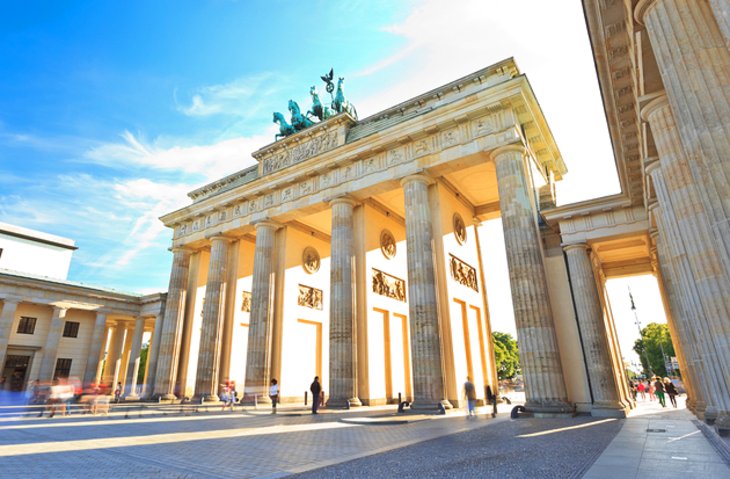
Berlin’s most famous historic landmark is undoubtedly the Brandenburg Gate (Brandenburger Tor). Once a symbol of a divided nation, it now stands as a symbol of unity and peace. This impressively large Neoclassical gate was commissioned by King Frederick Wilhelm II in 1788, and its design was inspired by the Propylaea in Athens’ Acropolis. The sandstone monument is 26 meters tall, standing in the Mitte district’s Pariser Platz, just a block from the Reichstag building.
It is located in the western part of the city centre of Berlin within Mitte, at the junction of Unter den Linden and Ebertstraße, immediately west of the Pariser Platz. One block to the north stands the Reichstag building, which houses the German parliament (Bundestag). The gate is the monumental entry to Unter den Linden, a boulevard of linden trees which led directly to the royal City Palace of the Prussian monarchs.
Throughout its existence, the Brandenburg Gate was often a site for major historical events and is today considered not only as a symbol of the tumultuous histories of Germany and Europe, but also of European unity and peace.
2.The built Reichstag
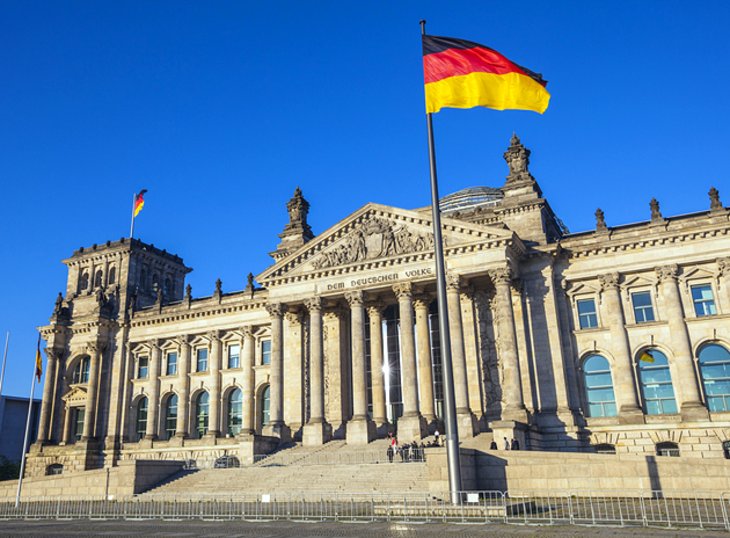
The Reichstag (Reichstagsgebäude) was originally completed in 1894 where the Neo-Renaissance palace served as the home of the German Empire’s Imperial Diet until it burned in 1933. It was not used again until after the reunification of Germany, at which point it underwent a 10-year reconstruction and finally became the home of the German Parliament in 1999.
A highlight of this magnificent reconstruction is the replacement dome, the Kuppel. Made of glass, it offers superb views of the surrounding city, especially at night from the Rooftop Restaurant. If visiting in the summer months, be sure to check into the schedule of light shows and film nights for a memorable Berlin experience.
In World War II, during the Battle of Berlin, the building was severely damaged by the Soviet Red Army. After the War, the building fell into disuse; the parliament of the German Democratic Republic (the Volkskammer) met in the Palast der Republik in East Berlin, while the parliament of the Federal Republic of Germany (the Bundestag) met in the Bundeshaus in Bonn.
The ruined building was made safe against the elements and partially refurbished in the 1960s, but no attempt at full restoration was made until after German reunification on 3 October 1990, when it underwent a reconstruction led by architect Norman Foster. After its completion in 1999, it once again became the meeting place of the German parliament: the contemporary Bundestag.
3.Museum Island

The Museum Island is a museum complex on the northern part of the Spree Island in the historic heart of Berlin. It is one of the most visited sights of Germany’s capital and one of the most important museum sites in Europe.
Sandwiched between the River Spree and the Kupfergraben in a 400-meter-long canal, Spree Island – better known as Museum Island (Museumsinsel) – is one of the city’s most important UNESCO World Heritage Sites. Here, you’ll find many of the city’s oldest and most important museums, including the Old Museum (Altes Museum), built in 1830 to house the Crown Jewels and other royal treasures.
The New Museum (Neues Museum), destroyed during WWII, was rebuilt and opened again in 2009. It serves as the home of extensive collections from the Egyptian Museum, the Papyrus Collection, and the Collection of Classical Antiquities.
The Museum Island (German: Museumsinsel) is a museum complex on the northern part of the Spree Island in the historic heart of Berlin. It is one of the most visited sights of Germany’s capital and one of the most important museum sites in Europe. Built from 1830 to 1930 by order of the Prussian Kings according to plans by five architects, Museum Island was designated a UNESCO World Heritage Site in 1999 because of its testimony to the architectural and cultural development of museums in the 19th and 20th centuries. It consists of the Altes Museum, the Neues Museum, the Alte Nationalgalerie, the Bode-Museum and the Pergamonmuseum.As Museum Island includes all of Spree Island north of the Unter den Linden, the Berliner Dom is also located here, near the Lustgarten. To the south, the reconstructed Berlin Palace houses the Humboldt Forum museum and opened in 2020. Since German reunification, the Museum Island has been rebuilt and extended according to a master plan. In 2019, a new visitor center and art gallery, the James Simon Gallery, was opened.
4.The Berlin Wall Memorial

The Gedenkstätte Berliner Mauer commemorates the division of Berlin by the Berlin Wall and the deaths that occurred there. The monument was created in 1998 by the Federal Republic of Germany and the Federal State of Berlin.
The Berlin Wall originated in 1961 when East Germany sealed off that half of the city to prevent citizens from fleeing to West Germany. By the time it was torn down in 1989, the four-meter-high wall extended 155 kilometers, dissected 55 streets, and possessed 293 observation towers and 57 bunkers.
Today, only small stretches of this graffiti-covered travesty remain, including a 1.4-kilometer stretch preserved as part of the Berlin Wall Memorial (Gedenkstätte Berliner Mauer). It stands as a chilling reminder of the animosity that once divided Europe.
The Gedenkstätte Berliner Mauer (Berlin Wall Memorial) commemorates the division of Berlin by the Berlin Wall and the deaths that occurred there. The monument was created in 1998 by the Federal Republic of Germany and the Federal State of Berlin. It is located on Bernauer Straße at the corner of Ackerstraße and includes a Chapel of Reconciliation, the Berlin Wall Documentation Centre, a 60-metre (200 ft) section of the former border, a window of remembrance and a visitor center.
The idea of a memorial was suggested by the Deutsches Historisches Museum (German Historical Museum) on behalf of the federal government of Berlin, and architects Kohlhoff & Kohlhoff were commissioned to design it. The cost of the competition and completion was 2.2 million Marks. The federal government took over the construction costs, while the state covers the maintenance costs. On 11 September 2008 the Berlin House of Representatives approved the opening of the memorial on the anniversary of the day that the Berlin Wall fell.
By 2013, an extension was to be completed. Original relics of the border were to be shown, with missing parts marked in steel on the ground. The memorial was to be divided into four areas:
The wall and the Todesstreifen (death strip)
Destruction of the city
Building of the wall
“Es geschah an der Mauer” (It happened at the wall)
5. Berlin’s Television Tower
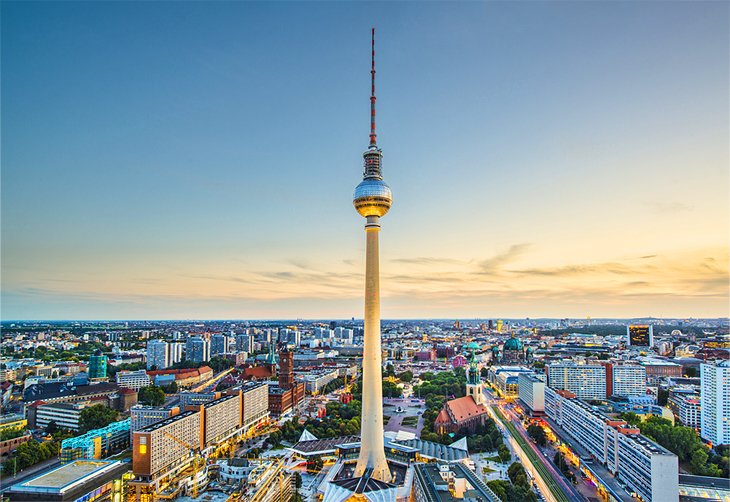
The Berliner Fernsehturm or Fernsehturm Berlin (English: Berlin Television Tower) is a television tower in central Berlin, Germany.
Located in the Marien quarter (Marienviertel), close to Alexanderplatz in the locality and district of Mitte, the tower was constructed between 1965 and 1969 by the government of the German Democratic Republic (East Germany). It was intended to be both a symbol of Communist power and of the city. It remains a landmark today, visible throughout the central and some suburban districts of Berlin. With its height of 368 metres (including antenna) it is the tallest structure in Germany, and the third-tallest structure in the European Union. When built it was the fourth-tallest freestanding structure in the world after the Ostankino Tower, the Empire State Building and 875 North Michigan Avenue, then known as The John Hancock Center.
Of the four tallest structures in Europe, it is 2 m shorter than the Torreta de Guardamar, 0.5 m shorter than the Riga Radio and TV Tower, and 8 m taller than the Trbovlje Power Station in 2017. The structure is also more than 220 metres higher than the old Berlin Radio Tower in the western part of the city, which was built in the 1920s.
In addition to its main function as the location of several radio and television broadcasting stations, the building – internally known as “Fernmeldeturm 32” – serves as a viewing tower with observation deck including a bar at a height of 203 metres, as well as a rotating restaurant. Also, the Berlin TV Tower can be booked as a venue for events. The distinctive city landmark has undergone a radical, symbolic transformation: After German reunification, it changed from a politically charged, national symbol of the GDR into a citywide symbol of a reunited Berlin. Due to its universal and timeless design, it has increasingly been used as a trademark and is identified worldwide with Berlin and Germany. In 1979, the Berlin TV Tower received monument status by the GDR, a status which was perpetuated after the German reunification.
6.Checkpoint Charlie Museu
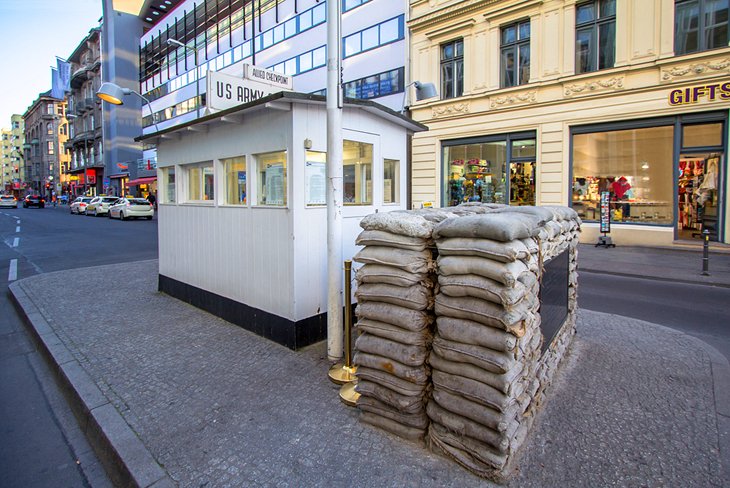
The Checkpoint Charlie Museum is a private museum in Berlin. It is named after the famous crossing point on the Berlin Wall, and was created to document the so-called “best border security system in the world”.
Also of interest is the Checkpoint Charlie Museum (Museum Haus am Checkpoint Charlie). Marking the best-known crossing point between East and West Berlin, this fascinating tourist attraction features numerous displays and artifacts tracing the history of human rights, along with exhibits dealing specifically with the history of the Berlin Wall, and Checkpoint Charlie.
Situated next to the original guardhouse, the museum also highlights some of the most interesting attempts made by those trying to escape communist rule. These include an original homemade air balloon used in one successful attempt.
The Checkpoint Charlie Museum (German: Das Mauermuseum – Museum Haus am Checkpoint Charlie) is a private museum in Berlin. It is named after the famous crossing point on the Berlin Wall, and was created to document the so-called “best border security system in the world” (in the words of East German general Heinz Hoffmann). On display are the photos and related documents of successful escape attempts from East Germany, together with the escape apparatus: hot-air balloons, getaway cars, chairlifts, and a mini-U-boat. The museum researches and maintains a list of deaths at the Berlin Wall. It is operated by the Mauermuseum-Betriebs gGmbH,[1] and the director is Alexandra Hildebrandt.
7.Pergamon Museum
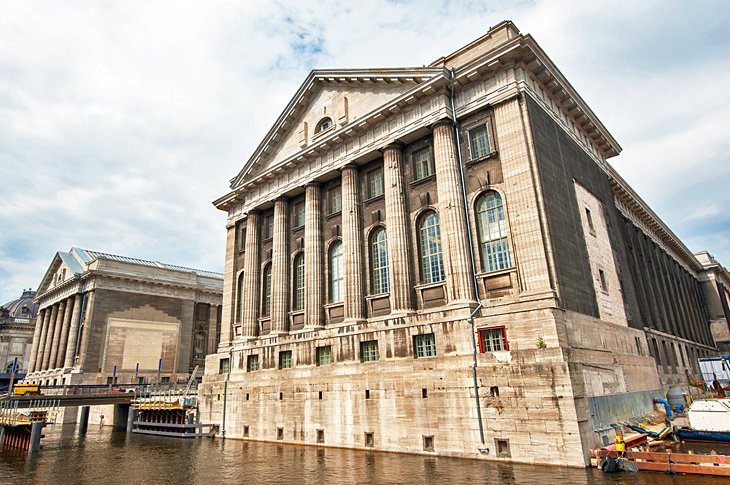
The Pergamon Museum is a listed building on the Museum Island in the historic centre of Berlin. It was built from 1910 to 1930 by order of German Emperor Wilhelm II according to plans by Alfred Messel and Ludwig Hoffmann in Stripped Classicism style.
The Pergamon, the most visited of the Museum Island attractions, is also one of Berlin’s top sightseeing destinations. It is home to three main galleries, each occupying a wing of the massive building, including the Middle East Museum, the Islamic Art Museum, and the Antiquity collection.
The artifacts, which narrowly escaped harm during WWII, were collected by German archaeologists during the 19th and 20th centuries from excursions to Egypt, the Middle East, and Asia. Primarily focused on architectural marvels, including ornate façades and gates, some of the museum’s most famous pieces are the Ishtar Gate of Babylon, the Roman Market Gate of Miletus, and the Mshatta Façade. A café and bookshop are located on-site.
The Pergamon Museum (German: Pergamonmuseum; pronounced [ˈpɛʁ.ɡa.mɔn.muˌzeː.ʊm] ) is a listed building on the Museum Island in the historic centre of Berlin. It was built from 1910 to 1930 by order of German Emperor Wilhelm II according to plans by Alfred Messel and Ludwig Hoffmann in Stripped Classicism style. As part of the Museum Island complex, the Pergamon Museum was inscribed on the UNESCO World Heritage List in 1999 because of its architecture and testimony to the evolution of museums as architectural and social phenomena.
Currently, the Pergamon Museum is home to the Antikensammlung including the famous Pergamon Altar, the Vorderasiatisches Museum and the Museum für Islamische Kunst. Parts of the building are closed for renovation until 2025.
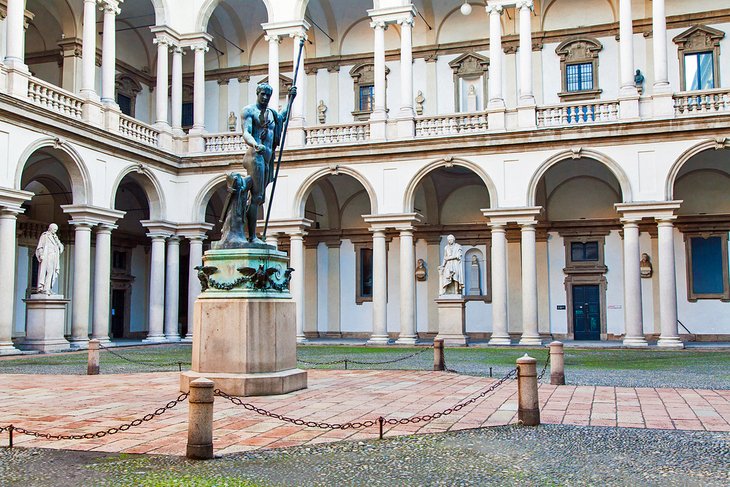
by Best-Mag Magazine Editorial | Travel
Milan, a metropolis in Italy’s northern Lombardy region, is a global capital of fashion and design. Home to the national stock exchange, it’s a financial hub also known for its high-end restaurants and shops. The Gothic Duomo di Milano cathedral and the Santa Maria delle Grazie convent, housing Leonardo da Vinci’s mural “The Last Supper,” testify to centuries of art and culture.
Milan is considered a leading alpha global city, with strengths in the fields of art, chemicals, commerce, design, education, entertainment, fashion, finance, healthcare, media (communication), services, research and tourism. Its business district hosts Italy’s stock exchange (Italian: Borsa Italiana), and the headquarters of national and international banks and companies. In terms of GDP, Milan is the wealthiest city in Italy, has the third-largest economy among EU cities after Paris and Madrid, and is the wealthiest among EU non-capital cities. Milan is viewed along with Turin as the southernmost part of the Blue Banana urban development corridor (also known as the “European Megalopolis”), and one of the Four Motors for Europe.
The city’s role as a major political centre dates back to the late antiquity, when it served as the capital of the Western Roman Empire, while from the 12th century until the 16th century, Milan was one of the largest European cities, and a major trade and commercial centre, consequently becoming the capital of the Duchy of Milan, which was one of the greatest political, artistic and fashion forces in the Renaissance. Despite losing much of its political and cultural importance in the early modern period, the city regained its status as a major economic and political centre, being considered today as the industrial and financial capital of Italy.
1.Leonardo da Vinci’s Last Supper

The Last Supper is a mural painting by the Italian High Renaissance artist Leonardo da Vinci, dated to c. 1495–1498.
The Gothic brick church of Santa Maria delle Grazie, in the Corso Magenta, was begun about 1465, and its massive six-sided dome in the finest Early Renaissance style was designed by Bramante, one of Italy’s most influential Renaissance architects.
The church – and adjoining refectory, which holds Leonardo da Vinci’s Last Supper – were badly damaged in World War II, and during the repair work, old sgraffito paintings in the dome were brought to light. At the end of the north aisle is the Baroque chapel of the Madonna delle Grazie, with an altarpiece of the Madonna.
But the reason most tourists visit Santa Maria delle Grazie is to see da Vinci’s most famous work, painted on the refectory wall of the former Dominican monastery. The Cenacolo Vinciano, as it is called here, was painted on the wall in tempera between 1495 and 1497.
The work was commissioned as part of a plan of renovations to the church and its convent buildings by Leonardo’s patron Ludovico Sforza, Duke of Milan. In order to permit his inconsistent painting schedule and frequent revisions, it is painted with materials that allowed for regular alterations: tempera on gesso, pitch, and mastic. Due to the methods used, a variety of environmental factors, and intentional damage, little of the original painting remains today despite numerous restoration attempts, the last being completed in 1999. Housed in the refectory of the Convent of Santa Maria delle Grazie in Milan, Italy, The Last Supper is his largest work, aside from the Sala delle Asse.
2.Il Duomo (Milan Cathedral)

Milan Cathedral, or Metropolitan Cathedral-Basilica of the Nativity of Saint Mary, is the cathedral church of Milan, Lombardy, Italy. Dedicated to the Nativity of St Mary, it is the seat of the Archbishop of Milan, currently Archbishop Mario Delpini.
The massive Cathedral of Santa Maria Nascente, which the Milanese call just “Il Duomo” is among the world’s largest (it holds up to 40,000 people) and most magnificent churches, the ultimate example of the Flamboyant Gothic style. It was begun in the 14th century, but its façade was not completed until the early 1800s, under Napoleon.
The roof is topped by 135 delicately carved stone pinnacles and the exterior is decorated with 2,245 marble statues. The dim interior, in striking contrast to the brilliant and richly patterned exterior, makes a powerful impression with its 52 gigantic pillars. The stained-glass windows in the nave (mostly 15th-16th centuries) are the largest in the world; the earliest of them are in the south aisle.
The cathedral took nearly six centuries to complete: construction began in 1386, and the final details were completed in 1965. It is the largest church in the Italian Republic—the larger St. Peter’s Basilica is in the State of Vatican City, a sovereign state—and possibly the second largest in Europe and the third largest in the world (its size and position remain a matter of debate).
3.Castello Sforzesco

The Castello Sforzesco is a medieval fortification located in Milan, northern Italy. It was built in the 15th century by Francesco Sforza, Duke of Milan, on the remnants of a 14th-century fortification. Later renovated and enlarged, in the 16th and 17th centuries it was one of the largest citadels in Europe.
The Castello Sforzesco, held by the Visconti and the Sforza families who ruled Milan from 1277 to 1447 and from 1450 to 1535 respectively, was built in 1368 and rebuilt in 1450. The 70-meter Torre de Filarete is a 1905 reproduction of the original gate-tower.
The Castello houses the Musei del Castello Sforzesco, a series of museums, one of which features sculpture. The collection includes the Pietà Rondanini, Michelangelo’s last masterpiece, brought here in 1953 from the Palazzo Rondanini in Rome.
Other museums feature a collection of decorative art, prehistoric and Egyptian antiquities, a collection of musical history, and an armory of weapons and medieval armor.
The Castello Sforzesco (Italian for “Sforza’s Castle”) is a medieval fortification located in Milan, northern Italy. It was built in the 15th century by Francesco Sforza, Duke of Milan, on the remnants of a 14th-century fortification. Later renovated and enlarged, in the 16th and 17th centuries it was one of the largest citadels in Europe. Extensively rebuilt by Luca Beltrami in 1891–1905, it now houses several of the city’s museums and art collections.
4.Pinacoteca di Brera

The Pinacoteca di Brera is the main public gallery for paintings in Milan, Italy. It contains one of the foremost collections of Italian paintings from the 13th to the 20th century, an outgrowth of the cultural program of the Brera Academy, which shares the site in the Palazzo Brera.
The Renaissance Palazzo di Brera, built between 1651 and 1773, was originally a Jesuit college, but since 1776 has been the Accademia di Belle Arti (Academy of Fine Arts). Along with a library and observatory, it contains the Pinacoteca di Brera, one of Italy’s finest art museums.
Much of the art was acquired as churches closed or were demolished, and the museum is especially strong in paintings by northern Italian masters. As you enter through the courtyard, you’ll see an 1809 monument to Napoleon I by the sculptor Canova.
Notable among 15th-century pictures are works by Mantegna (Madonna in a Ring of Angels’ Heads and Lamentation). The Venetian masters are represented by Giovanni Bellini (Lamentation and two Madonnas), Paolo Veronese, Titian (Count Antonio Porcia and St. Jerome), and Tintoretto (Finding of St. Mark’s Body and Descent from the Cross), and portraits by Lorenzo Lotto and Giovanni Battista Moroni.
De galerij is gevestigd in een barok paleis, Palazzo Brera, samen met de oude bibliotheek van Brera (Biblioteca Nazionale Braidense), het Lombardisch Instituut voor Wetenschap en Letteren (Istituto Lombardo Accademia di Scienze e Lettere), de Sterrenwacht en de Botanische Tuin (Osservatorio Astronomico e Giardino Botanico di Brera) en de Academie voor Schone Kunsten (l’Accademia di Belle Arti di Brera).
5.Sant’Ambrogio
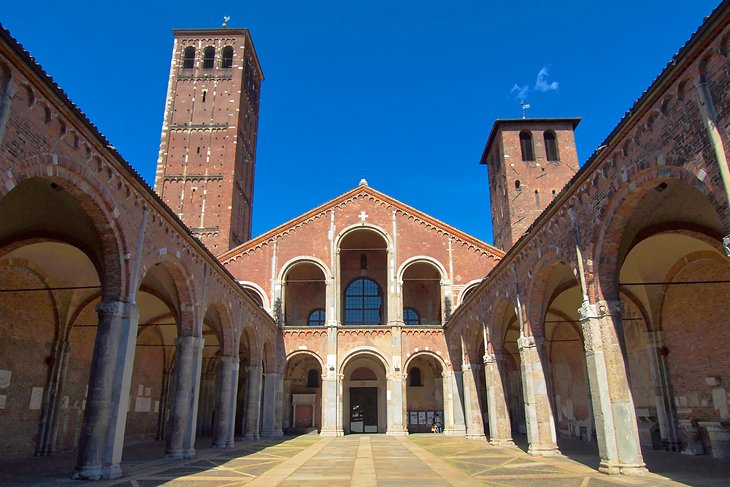
Ambrose of Milan, venerated as Saint Ambrose, was a theologian and statesman who served as Bishop of Milan from 374 to 397. He expressed himself prominently as a public figure, fiercely promoting the Christian faith against Arianism and paganism.
The church of Sant’Ambrogio was founded in 386 by St. Ambrose, who was born in Milan and is the city’s patron saint. The present church is a masterpiece of Romanesque architecture, built in the 12th century around the choir from an earlier ninth-century church.
There’s a lot to see here, beginning with the large portico, also from the ninth century, and the atrium, whose carved stone capitals and portal rank it high among Europe’s best examples of the Romanesque period.
Inside, be sure to see the pulpit with late Romanesque carving, and the richly carved 4th-century Stilicone sarcophagus underneath it. The casing (paliotto) of the high altar is a masterpiece of Carolingian art made in 835 at either Milan or Rheims. It’s easy to miss the mosaic dome of the original 4th-century Sacello di San Vittore, accessed through the last chapel on the right.
ne of the most ancient churches in Milan, it was built by St. Ambrose in 379–386, in an area where numerous martyrs of the Roman persecutions had been buried. The first name of the church was in fact Basilica Martyrum.
When St. Ambrose arrived in Milan, the local churches were in conflict with each other over the conflict between Arianism and the Nicene Creed as well as numerous local issues. He was firmly in support of the Nicene side of the conflict and wanted to make northern Italy into a pro-Rome stronghold. He did this through both preaching and construction. He built three or four churches surrounding the city; Basilica Apostolorum (now San Nazaro in Brolo), Basilica Virginum (now San Simpliciano), and Basilica Martyrum (which was later renamed in his honour). A fourth church, Basilica Salvatoris (now San Dionigi), is attributed to him as well, but may not actually be from the 4th century. These churches were dedicated with anti-Arian language and as symbols of the wealth and power of the pro-Nicene faction in Milan.
6.San Maurizio and the Archaeology Museum
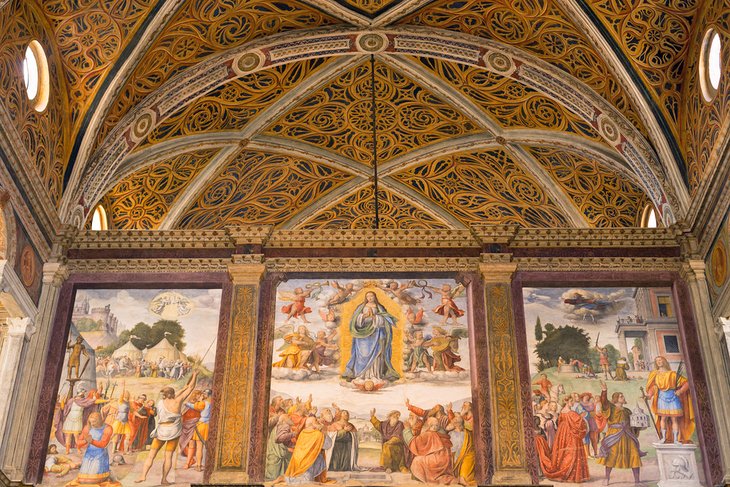
The Archaeological Museum of Milan is located in the ex-convent of the Monastero Maggiore, alongside the ancient church of San Maurizio al Monastero Maggiore, with entrance on Corso Magenta.
To many, the interior of the church of San Maurizio is the most beautiful in Milan. Built in the early 1500s as the church for a convent of Benedictine nuns, the entire interior is covered in frescoes of biblical scenes. Not only are these by some of the best Lombard artists of the 16th century – principally Bernardino Luini and his sons – but the colors of the paintings are as vivid as if they’d been painted yesterday. The long nave is divided into two sections, the rear one reserved as the nuns’ choir.
The extensive monastery was built over the ruins of the Roman circus and portions of the Roman walls, all now part of the Civico Museo Archeologico (Archaeology Museum), where you can see these excavated remains of Roman Milan.
Collections of the museum from prehistoric and Egyptian civilisations are housed at the Castello Sforzesco Museums.
Statues and tombs from ancient Rome are displayed along the cloisters of the former monastery, and a path leads from the cloisters to a “polygonal tower (late third century) with early medieval frescoes (thirteenth century) and comes out in the new museum in Via Nirone where the early medieval section is on the first floor.
7.Poldi-Pezzoli Museum
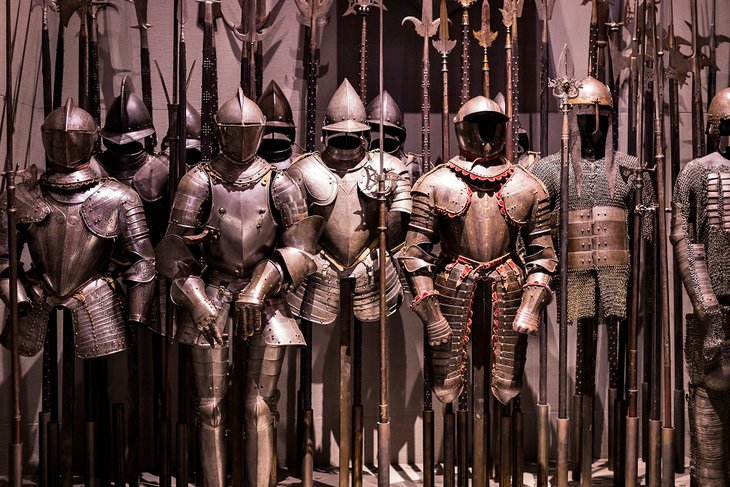
The Museo Poldi Pezzoli is an art museum in Milan, Italy. It is located near the Teatro alla Scala, on Via Manzoni 12. The museum was originated in the 19th century as a private collection of Gian Giacomo Poldi Pezzoli and his mother, Rosa Trivulzio, of the family of the condottiero Gian Giacomo Trivulzio.
Pezzoli in his testament left the house and contents to the Brera Academy. Giuseppe Bertini, director of the Academy, opened the museum on 25 April 1881. During World War II, the palazzo suffered severe damage, but the artworks had been placed in safe storage. The museum was reopened in 1951 after reconstruction.
An elegant old patrician house is the setting for this art museum, which originated in the 19th century as the private collection of Gian Giacomo Poldi Pezzoli and his mother, Rosa Trivulzio. Highlights are paintings by Botticelli, Mantegna, Piero della Francesca, Guardí, and other artists, as well jewelry, silver, bronzes, porcelains, Etruscan pottery, armor, and weapons.
Textiles in the museum include Flemish and Persian carpets, tapestries, a large collection of hand-worked lace, and a very rare embroidery designed by Botticelli.
The museum is notable for its broad collection of Northern Italian and Netherlandish/Flemish artists. The exhibition includes weaponry, glassworks, ceramics, jewelry, and furnishings.
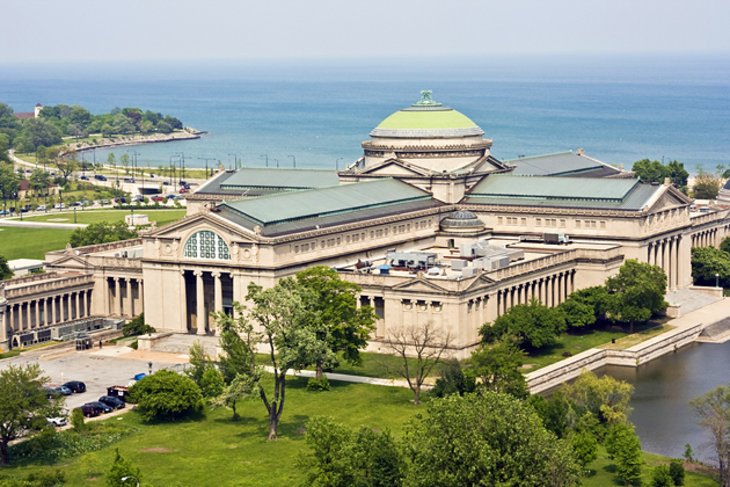
by Best-Mag Magazine Editorial | Travel
Chicago, on Lake Michigan in Illinois, is among the largest cities in the U.S. Famed for its bold architecture, it has a skyline punctuated by skyscrapers such as the iconic John Hancock Center, 1,451-ft. Willis Tower (formerly the Sears Tower) and the neo-Gothic Tribune Tower. The city is also renowned for its museums, including the Art Institute of Chicago with its noted Impressionist and Post-Impressionist works.
On the shore of Lake Michigan, Chicago was incorporated as a city in 1837 near a portage between the Great Lakes and the Mississippi River watershed. It grew rapidly in the mid-19th century; by 1860, Chicago was the youngest U.S. city to exceed a population of 100,000. The Great Chicago Fire in 1871 destroyed several square miles and left more than 100,000 homeless but Chicago’s population continued to grow to 503,000 by 1880 and then doubled to more than a million within the decade.The construction boom accelerated population growth throughout the following decades, and by 1900, less than 30 years after the fire, Chicago was the fifth-largest city in the world.Chicago made noted contributions to urban planning and zoning standards, including new construction styles (such as, Chicago School architecture, the development of the City Beautiful Movement, and the steel-framed skyscraper).
1. Art Institute of Chicago
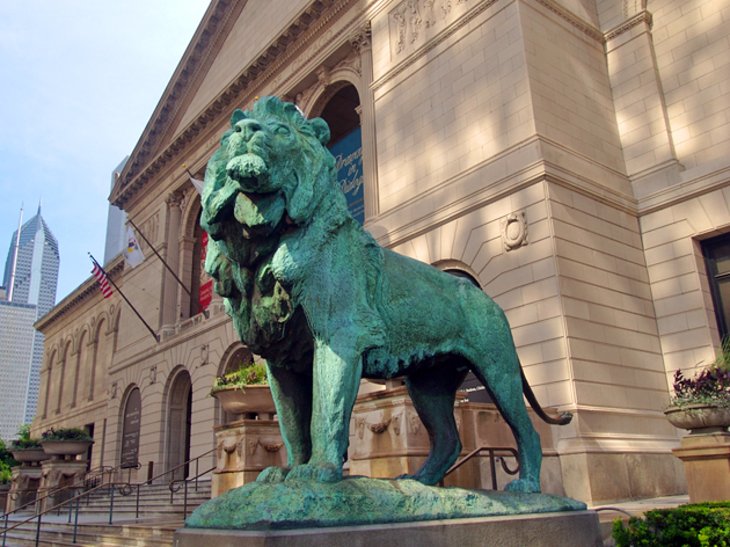
Renowned art museum holding nearly 300,000 works from all over the world, spanning many centuries.
the Art Institute of Chicago is a world class museum with hundreds of thousands of artworks. The diverse collection spans thousands of years and includes pieces from a variety of media including painting, prints, photography, sculpture, decorative arts, textiles, architectural drawings and more.
The Institute is known for its collection of impressionist and post-Impressionist paintings including Georges Seurat’s 1884 A Sunday Afternoon on La Grande Jatte, Renoir’s 1879 Acrobats at the Cirque Fernando, and numerous paintings by Claude Monet.
As a research institution, the Art Institute also has a conservation and conservation science department, five conservation laboratories, and one of the largest art history and architecture libraries in the country—the Ryerson and Burnham Libraries.
The growth of the collection has warranted several additions to the museum’s 1893 building, which was constructed for the World’s Columbian Exposition. The most recent expansion, the Modern Wing designed by Renzo Piano, opened in 2009 and increased the museum’s footprint to nearly one million square feet, making it the second-largest art museum in the United States, after the Metropolitan Museum of Art.The Art Institute is associated with the School of the Art Institute of Chicago, a leading art school, making it one of the few remaining unified arts institutions in the United States.
In 2017, the Art Institute received 1,619,316 visitors, and was the 35th most-visited art museum in the world. However, in 2020, due to the COVID-19 pandemic, the museum was closed for 169 days, and attendance plunged by 78 percent from 2019, to 365,660.
2. Navy Pier
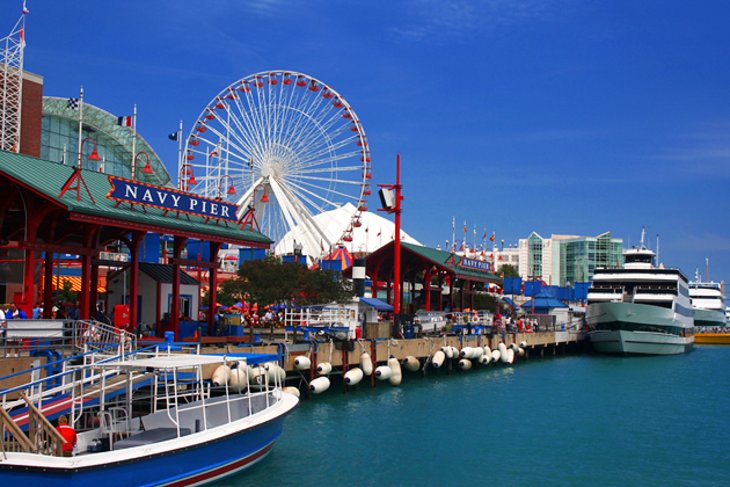
Navy Pier is a 3,300-foot-long pier on the shoreline of Lake Michigan, located in the Streeterville neighborhood of the Near North Side community area in Chicago, Illinois, United States.
The Navy Pier originally opened in 1916 as an amusement area and shipping facility but is now one of Chicago’s most popular tourist attractions. Today, the Navy Pier is made up of 50 acres of gardens, attractions, shops, restaurants, concert venues, and parks. There is a 150-foot Ferris wheel and an historic carousel in Navy Pier Park.
Visitors can also watch a film at the 3D Imax Theater, watch actors perform the classics at the Chicago Shakespeare Theater, or visit Crystal Gardens, a one-acre, six-story, indoor botanical garden. Also located here is the Chicago Children’s Museum. The Pier hosts year-round festivities, including the Chicago Festival in August. Cruise ships leave from here on various sightseeing excursions.
Navy Pier is a 3,300-foot-long (1,010 m) pier on the shoreline of Lake Michigan, located in the Streeterville neighborhood of the Near North Side community area in Chicago, Illinois, United States. Navy Pier encompasses over 50 acres (20 ha) of parks, gardens, shops, restaurants, family attractions and exhibition facilities and is one of the top destinations in the Midwestern United States, drawing over nine million visitors annually. It is one of the most visited attractions in the entire Midwest and is Chicago’s second-most visited tourist attraction.
3.Reach for the Stars at Adler Planetarium

The Adler Planetarium is a public museum in Chicago, Illinois, dedicated to astronomy and astrophysics. It was founded in 1930 by local businessman Max Adler. Located on the northeastern tip of Northerly Island on Lake Michigan in the city, the Adler Planetarium was the first planetarium in the United States.
The Adler Planetarium is leaps and bounds beyond the ones most kids get to visit on school trips, and all ages will appreciate the shows and comprehensive exhibits it has to offer. The Adler prides itself in being the first planetarium in the Western Hemisphere, built in 1930 on the shore of Lake Michigan.
The planetarium is home to two dome theaters, which offer a variety of shows, including exploration of Chicago’s night sky, the solar system, and the moon. There is also an extensive array of exhibits that explore topics including life on other worlds, meteors and meteorites, space exploration, the history of the scientific discipline, and even the history of astrology.
Het Adler Planetarium and Astronomy Museum in Chicago (Illinois) was het eerste planetarium In de VS en is het oudste nog bestaande planetarium Het Adler werd in 1930 gebouwd door filantroop Max Adler, met hulp van de eerste directeur van het planetarium, Philip Fox. Door de ligging op het Northerly Island maakt het deel uit van de Museum Campus Chicago, samen met het Shedd Aquarium en het Field Museum of Natural History. In 1987 werd het tot National Historic Landmark verklaard.
Het Adler is het enige museum ter wereld met twee volledige planetariumtheaters. Sinds de opening in 1930 kunnen bezoekers representaties van de sterrenhemel zien in het historische Sky Theater-planetarium, waarvan de koepel van buitenaf te zien is.
4.Museum of Science and Industry

At the north end of Jackson Park is the Museum of Science and Industry, founded in 1933, and arguably the most impressive museum in Chicago. It is devoted to the application of natural laws in technological and industrial development.
The museum is thought to be the first in the U.S. to incorporate the idea of “hands-on” exhibits. Visitors are encouraged to interact with hundreds of exhibits. The MSI features permanent and changing exhibits, as well as an OMNIMAX theater.
The Museum of Science and Industry (MSI) is a science museum located in Chicago, Illinois, in Jackson Park, in the Hyde Park neighborhood between Lake Michigan and The University of Chicago. It is housed in the former Palace of Fine Arts from the 1893 World’s Columbian Exposition. Initially endowed by Julius Rosenwald, the Sears, Roebuck and Company president and philanthropist, it was supported by the Commercial Club of Chicago and opened in 1933 during the Century of Progress Exposition.
Among the museum’s exhibits are a full-size replica coal mine, German submarine U-505 captured during World War II, a 3,500-square-foot (330 m2) model railroad, the command module of Apollo 8, and the first diesel-powered streamlined stainless-steel passenger train.
5. Watch the Water Show at Buckingham Fountain
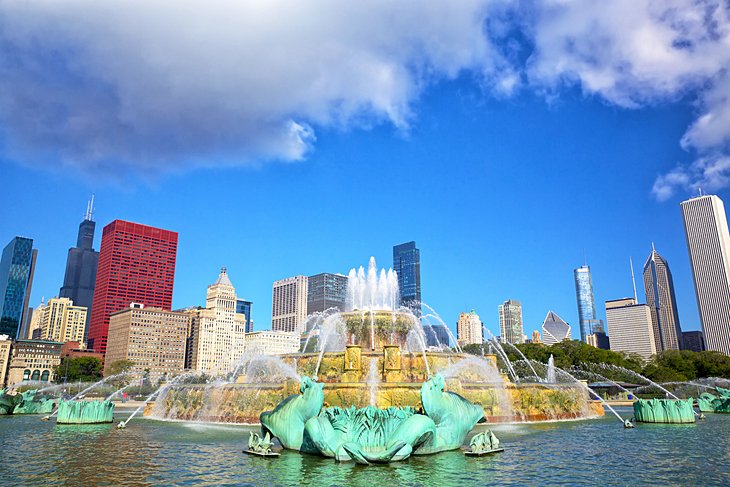
Buckingham Fountain is a Chicago Landmark in the center of Grant Park, between Queen’s Landing and Ida B. Wells Drive. Dedicated in 1927 and donated to the city by philanthropist Kate S. Buckingham, it is one of the largest fountains in the world.
Built in 1927 as a donation from the family, the Clarence Buckingham Memorial Fountain is one of the largest in the world. Designed in the period’s iconic Art Deco style, the central fountain is surrounded by four seahorses that represent Lake Michigan’s four bordering states. From 8am to 11pm, the fountain bursts to life hourly, shooting 15,000 gallons of water through nearly 200 nozzles each minute to create an impressive display.
Wells Drive. Dedicated in 1927 and donated to the city by philanthropist Kate S. Buckingham, it is one of the largest fountains in the world. Built in a rococo wedding cake style and inspired by the Latona Fountain at the Palace of Versailles, its design allegorically represents nearby Lake Michigan. The fountain operates from May to mid-October, with regular water shows and evening colored-light shows. During the winter, the fountain is decorated with festival lights.
6.Field Museum of Natural History
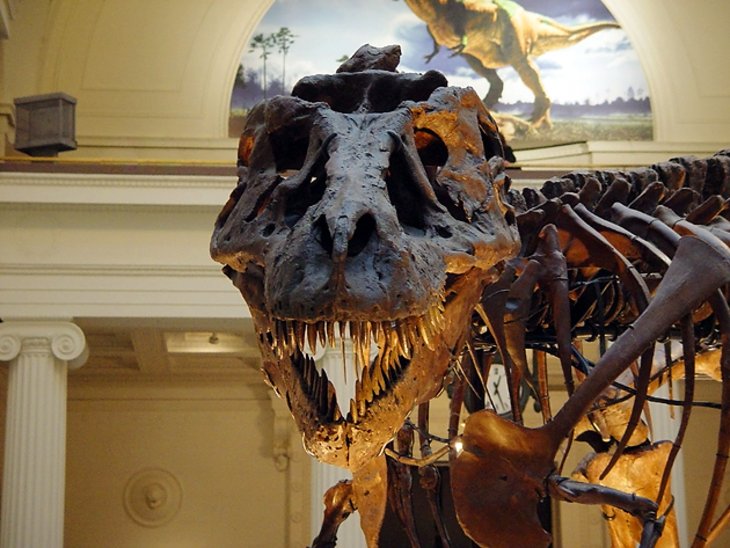
The Field Museum of Natural History, also known as The Field Museum, is a natural history museum in Chicago, Illinois, and is one of the largest such museums in the world.
The museum maintains a temporary exhibition program of traveling shows as well as in-house produced topical exhibitions. The professional staff maintains collections of over 24 million specimens and objects that provide the basis for the museum’s scientific-research programs These collections include the full range of existing biodiversity, gems, meteorites, fossils, and rich anthropological collections and cultural artifacts from around the globe The museum’s library, which contains over 275,000 books, journals, and photo archives focused on biological systematics, evolutionary biology, geology, archaeology, ethnology and material culture, supports the museum’s academic-research faculty and exhibit development.The academic faculty and scientific staff engage in field expeditions, in biodiversity and cultural research on every continent, in local and foreign student training, and in stewardship of the rich specimen and artifact collections. They work in close collaboration with public programming exhibitions and education initiatives.
Originally called the Columbian Museum of Chicago, the Field Museum of Natural History was founded in 1893 to showcase the biological and anthropological collections gathered for the World Columbian Exposition. The name changed in 1905 to honor Marshall Field, the department store owner, art patron, and major benefactor of the museum.
The permanent collection features approximately 20 million artifacts and specimens covering a variety of disciplines including geology, botany, zoology and anthropology. Of special note are the permanent displays on Ancient Egypt and the cultures of North, Central and South America and “Sue,” the world’s largest, most complete Tyrannosaurus rex skeleton. Special rotating exhibits take place on a regular basis throughout the year.
7.Lincoln Park
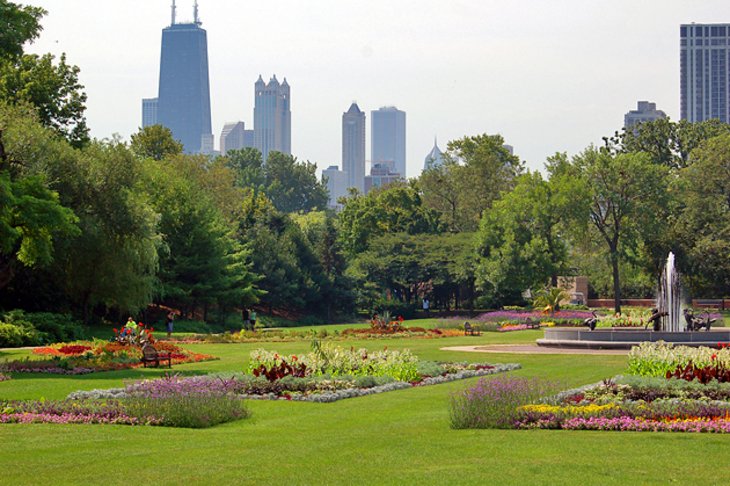
Lincoln Park is a six-mile stretch of green space along the edge of Lake Michigan, and Chicago’s biggest park. This popular park is home to the lovely Lincoln Park Conservatory and the Lincoln Park Zoo, one of the oldest zoos in the country. Also located here are the Peggy Notebaert Nature Museum, and the Chicago History Museum.
For those who simply want to enjoy the outdoor space there are playing fields, bike trails, jogging paths, and beaches. Visitors can see a number of significant statues and pieces of public art within the park grounds including Augustus Saint Gaudens’ Standing Statue of Lincoln (1887).
The band continued to explore a wider variation of musical types on their fourth album, A Thousand Suns (2010), layering their music with more electronic sounds. The band’s fifth album, Living Things (2012), combined musical elements from all of their previous records. Their sixth album, The Hunting Party (2014), returned to a heavier rock sound, and their seventh album, One More Light (2017), was a substantially more pop-oriented record. Linkin Park went on a hiatus when longtime lead vocalist Bennington died in July 2017. In April 2022, Shinoda revealed the band was neither working on new music nor planning on touring for the foreseeable future.
Linkin Park is among the best-selling bands of the 21st century and the world’s best-selling music artists, having sold over 100 million records worldwide. They have won two Grammy Awards, six American Music Awards, two Billboard Music Awards, four MTV Video Music Awards, 10 MTV Europe Music Awards and three World Music Awards. In 2003, MTV2 named Linkin Park the sixth-greatest band of the music video era and the third-best of the new millennium. Billboard ranked Linkin Park No. 19 on the Best Artists of the Decade list. In 2012, the band was voted as the greatest artist of the 2000s in a Bracket Madness poll on VH1. In 2014, the band was declared as “The Biggest Rock Band in the World Right Now” by Kerrang!
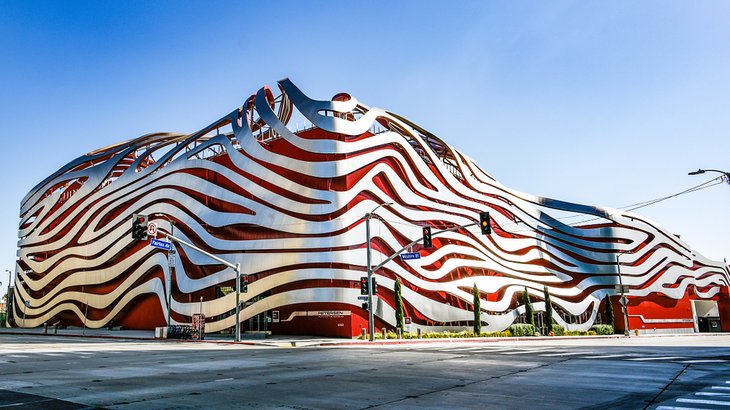
by Best-Mag Magazine Editorial | Travel
Los Angeles is a sprawling Southern California city and the center of the nation’s film and television industry. Near its iconic Hollywood sign, studios such as Paramount Pictures, Universal and Warner Brothers offer behind-the-scenes tours. On Hollywood Boulevard, TCL Chinese Theatre displays celebrities’ hand- and footprints, the Walk of Fame honors thousands of luminaries and vendors sell maps to stars’ homes.
Los Angeles is the commercial, financial, and cultural center of Southern California. With a population of roughly 3.9 million as of 2020, Los Angeles is known for its Mediterranean climate, ethnic and cultural diversity, Hollywood film industry, and sprawling metropolitan area. The city of Los Angeles lies in a basin in Southern California adjacent to the Pacific Ocean extending through the Santa Monica Mountains and into the San Fernando Valley. It covers about 469 square miles (1,210 km2), and is the seat of Los Angeles County, which is the most populous county in the United States with an estimated 9.86 million as of 2022.
Home to the Chumash and Tongva indigenous peoples, the area that became Los Angeles was claimed by Juan Rodríguez Cabrillo for Spain in 1542. The city was founded on September 4, 1781, under Spanish governor Felipe de Neve, on the village of Yaanga. It became a part of Mexico in 1821 following the Mexican War of Independence. In 1848, at the end of the Mexican–American War, Los Angeles and the rest of California were purchased as part of the Treaty of Guadalupe Hidalgo, and thus became part of the United States. Los Angeles was incorporated as a municipality on April 4, 1850, five months before California achieved statehood. The discovery of oil in the 1890s brought rapid growth to the city. The city was further expanded with the completion of the Los Angeles Aqueduct in 1913, which delivers water from Eastern California.
1.Griffith Park and Griffith Observatory

Griffith Observatory is an observatory in Los Angeles, California on the south-facing slope of Mount Hollywood in Griffith Park. It commands a view of the Los Angeles Basin including Downtown Los Angeles to the southeast, Hollywood to the south, and the Pacific Ocean to the southwest.
Griffith Park, in the eastern part of the Santa Monica Mountains, and covering an area of 4,210 acres, is the largest city park in Los Angeles. It’s home to the Los Angeles Zoo, the Griffith Observatory, a planetarium, and a Greek theater. It’s also home to golf courses, tennis courts, hiking trails, and a riding center created for the 1984 Olympic Games. And walking trails and scenic drives through the mountains offer views over the city and beyond.
The Griffith Observatory is one of the city’s most interesting experience-based attractions, and it’s all free to the public. On the grounds are exhibits and telescopes. The main highlight is a look through the Zeiss telescope, used for viewing the moon and planets. You can use the telescopes free each evening the facility is open. Also on-site are solar telescopes used for viewing the sun.
Het gebouw werd voor het eerst opengesteld aan het publiek op 14 mei 1935 en werd in de eerste 5 dagen bezocht door 13.000 mensen. Op 3 november 2006 werd het observatorium heropend na een renovatie en uitbreiding van vier jaar. Sinds 1974 is dr. Ed Krupp directeur van het observatorium.
De toegang tot het observatorium en de tentoonstellingen is gratis, geheel volgens de laatste wil van kolonel Griffith. Voor parkeren moet echter wel betaald worden. Voor het bekijken van de hoge-resolutievideo die met een laser op de binnenkant van een grote koepel in het planetarium geprojecteerd wordt, moet een bescheiden bijdrage betaald worden. Het observatorium is vijf dagen per week geopend, in de zomermaanden zes dagen per week.
Het gebouw is decor geweest in diverse bioscoopfilms, tv-films, tv-series en muziekvideoclips. Daarnaast werd het ook meermaals digitaal in beeld gebracht voor verschillende games.
2.Disneyland Resort
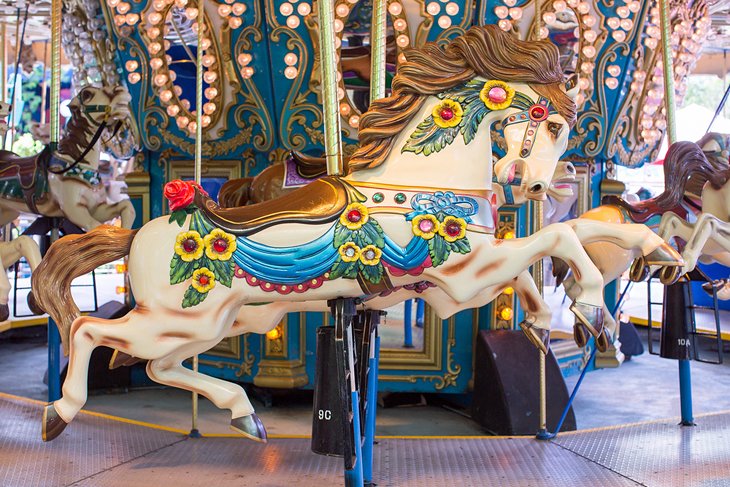
The Disneyland Resort, commonly known as Disneyland, is an entertainment resort in Anaheim, California.
ust outside Los Angeles, Disneyland is California’s premier family vacation destination, attracting visitors since the 1950s. Disneyland Park, with rides and experiences in elaborately created theme sets, is what most people picture when they imagine Disneyland. The Disneyland California Adventure Park, created during one of the expansions, holds even more action and adventure, with seven lands based on movie themes.
Relatively new to the scene are several Star Wars-themed rides. They include Star Wars Rise of the Resistance and the Millennium Falcon: Smuggler’s Run. The rides are in the new Star Wars Galaxy Edge area, which is full of shops and restaurants made out to look like the Black Spire Outpost on the planet of Batuu.
The resort was developed by Walt Disney in the 1950s. When it opened to guests on July 17, 1955, the property consisted of Disneyland, its 100-acre parking lot (which had 15,167 spaces),[1] and the Disneyland Hotel, owned and operated by Disney’s business partner Jack Wrather. After the success with the multi-park, multi-hotel business model at Walt Disney World in Lake Buena Vista, Florida, Disney acquired large parcels of land adjacent to Disneyland to apply the same business model in Anaheim.
3.Hollywood
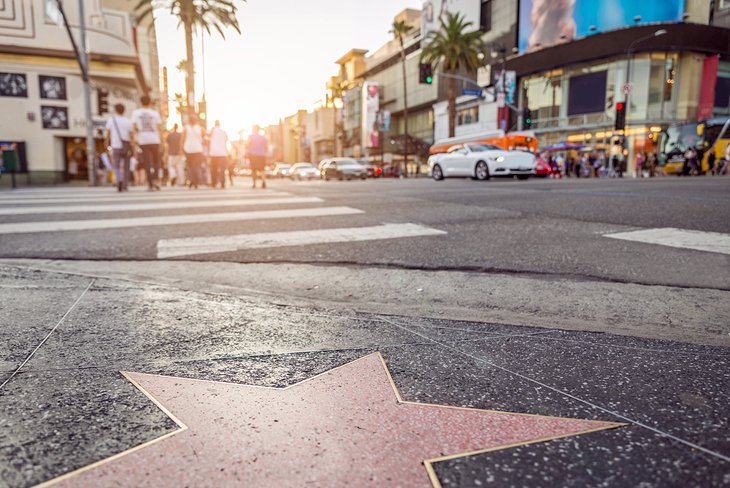
A larger-than-life symbol of the entertainment business, Hollywood beckons tourists with landmarks like TCL Chinese Theatre and star-studded Walk of Fame. Highlights include Paramount Pictures, historic music venues like the Hollywood Bowl, and Dolby Theatre, home of the Oscars. Scenesters can choose from improv comedy clubs, retro-cool bars and velvet-roped nightclubs. Locals frequent eateries in nearby Thai Town.
A suburb of Los Angeles, Hollywood is a destination in itself, with its own unique history and iconic sites. The attractions in Hollywood are closely associated with the film industry and the glamour of the silver screen.
The hillside Hollywood sign, Hollywood Boulevard, and the Chinese Theatre are some of the top places to visit. If you’re lucky, you might even spot a celebrity or two out for a shopping trip on Rodeo Drive. A fun family activity in Hollywood is finding all your favorite actors’ stars among the 2,500 plus on the Walk of Fame.
Sinds de stad als wijk opging in Los Angeles, heeft Hollywood geen eigen bestuursorgaan meer. Een tijdlang is er een informele burgemeester van Hollywood Mayor of Hollywood geweest, benoemd door de lokale kamer van koophandel (Hollywood Chamber of Commerce). Johnny Grant hield deze positie van 1980 tot zijn dood op 9 januari 2008 maar de functie is sindsdien niet meer ingevuld.
Bij de annexatie zijn de namen en nummers van de straten gewijzigd in de vorm zoals we ze heden ten dage kennen. Zo werd Prospect Avenue, gewijzigd in Hollywood Boulevard en werden alle nummers van dat district gewijzigd.
4.The Getty Center
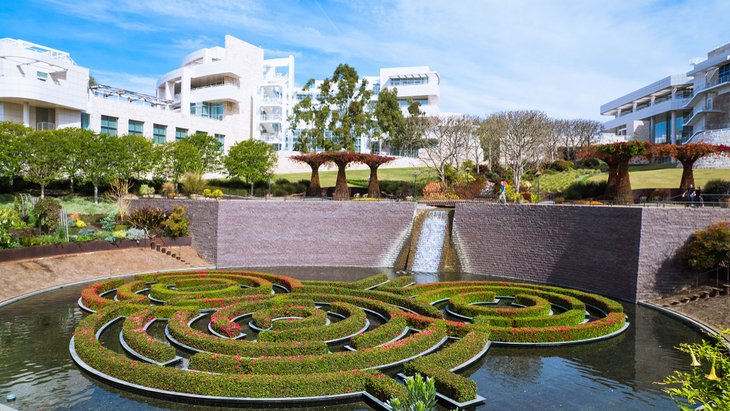
The Getty Center, in Los Angeles, California, is a campus of the Getty Museum and other programs of the Getty Trust. The $1.3 billion center opened to the public on December 16, 1997 and is well known for its architecture, gardens, and views overlooking Los Angeles.
On a hilltop in the Santa Monica Mountains, the Getty Center, designed by Richard Meier, is a huge complex measuring 0.75 square miles and set on 110 acres. The unique building and the beautiful grounds provide the perfect setting for this impressive museum. Collections include European paintings, drawings, sculpture, and decorative arts, as well as 19th- and 20th-century photography.
Located in the Brentwood neighborhood of Los Angeles, the center is one of two locations of the J. Paul Getty Museum and draws 1.8 million visitors annually. (The other location is the Getty Villa in the Pacific Palisades neighborhood of Los Angeles, California.) The center branch of the museum features pre-20th-century European paintings, drawings, illuminated manuscripts, sculpture, and decorative arts; and photographs from the 1830s through present day from all over the world.In addition, the museum’s collection at the center includes outdoor sculpture displayed on terraces and in gardens and the large Central Garden designed by Robert Irwin. Among the artworks on display is the Vincent van Gogh painting Irises.
Designed by architect Richard Meier, the campus also houses the Getty Research Institute (GRI), the Getty Conservation Institute, the Getty Foundation, and the J. Paul Getty Trust. The center’s design included special provisions to address concerns regarding earthquakes and fires.
5.Petersen Automotive Museum

The Petersen Automotive Museum is located on Wilshire Boulevard along Museum Row in the Miracle Mile neighborhood of Los Angeles. One of the world’s largest automotive museums, the Petersen Automotive Museum is a nonprofit organization specializing in automobile history and related educational programs.
Petersen Automotive Museum. Spread over four floors are a mix of permanent and temporary exhibits featuring more than 300 cars and motorcycles, ranging from perfectly preserved items from 1886 right through to concepts for the 21st century.
The museum underwent major renovations and is now one of the most modern institutions of its kind. The exterior façade is an eye-catching architectural masterpiece. For an additional fee, you can sign up for either a 90- or 120-minute guided Vault tour, which provides additional insight on rare and unusual cars.
Founded on June 11, 1994, by magazine publisher Robert E. Petersen and his wife Margie, the $40-million Petersen Automotive Museum is owned and operated by the Petersen Automotive Museum Foundation. The museum was originally located within the Natural History Museum of Los Angeles County, and later moved to a historic department store designed by Welton Becket. Opened in 1962, the building first served as a short-lived U.S. branch of Seibu Department Stores, before operating as an Ohrbach’s department store from 1965 to 1986. Six years after Ohrbach’s closed, Robert Petersen selected the largely windowless site as an ideal space for a museum—allowing artifacts to be displayed without harmful exposure to direct sunlight.
In 2015, the museum underwent an extensive $125 million renovation. The building’s façade was redesigned by the architectural firm Kohn Pedersen Fox, and features a stainless-steel ribbon assembly made of 100 tons of 14-gauge type 304 steel in 308 sections, 25 supports and 140,000 custom stainless-steel screws. Designers at The Scenic Route configured interior spaces to accommodate changing exhibits. The remodeled museum opened to the public on December 7, 2015.
6.Santa Monica
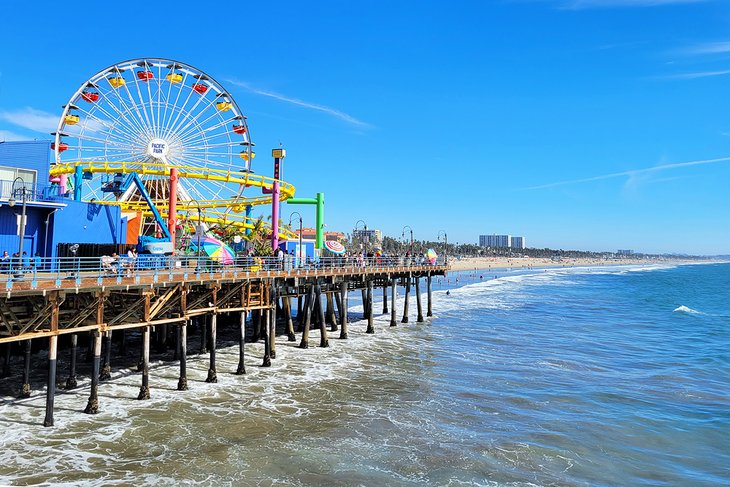
Santa Monica is a coastal city west of downtown Los Angeles. Santa Monica Beach is fringed by Palisades Park, with views over the Pacific Ocean. Santa Monica Pier is home to the Pacific Park amusement park, historic Looff Hippodrome Carousel and Santa Monica Pier Aquarium. Next to the pier is Muscle Beach, an outdoor gym established in the 1930s. In the city center, Bergamot Station houses several art galleries.
Santa Monica is a unique destination that is both chic and laid-back, with a population that ranges from surfers, skateboarders, and yoga devotees to techies and business people. The beautiful stretch of golden sand along the coast and the famous Santa Monica Pier, with its iconic Ferris wheel, are what most tourists come to enjoy, but you can find a variety of experiences in this beachfront city next to LA.
The downtown district of Santa Monica is lively throughout the day and night. Shoppers will find a range of options, from quirky vintage stores to high-end boutiques. Check out the Third Street Promenade for shopping and people watching, including catching the various street performers.
Santa Monica traces its history to Rancho San Vicente y Santa Monica, granted in 1839 to the Sepúlveda family of California. The rancho was later sold to John P. Jones and Robert Baker, who in 1875, along with his Californio heiress wife Arcadia Bandini de Stearns Baker, founded Santa Monica, which incorporated as a city in 1886. The city developed into a seaside resort during the late 19th and early 20th centuries, with the creation of tourist attractions such as Palisades Park, the Santa Monica Pier, Ocean Park, and the Hotel Casa del Mar.
7.California Science Center
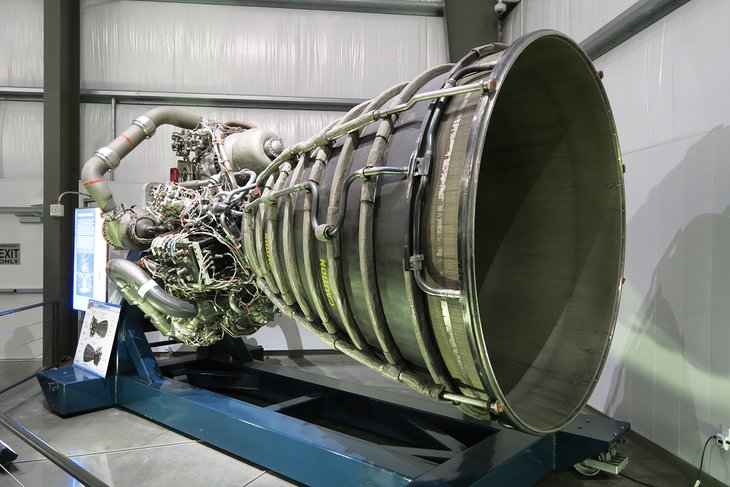
The California Science Center is a state agency and museum located in Exposition Park, Los Angeles, next to the Natural History Museum of Los Angeles County and the University of Southern California.
The California Science Center, open to the public free of charge, is home to the Space Shuttle Endeavour, as well as other major exhibits. Mission 26: The Big Endeavour is currently on display at the Samuel Oschin Pavilion, while the new Samuel Oschin Air and Space Center is being built. You can see the space shuttle, as well as artifacts from the space mission, and learn all about it and the people involved in the program.
Other exhibits at the Science Center cover such topics as the living world, technology, and ecosystems. The Ecosystems exhibit features an impressive 188,000-gallon kelp tank, as well as live plants, animals, and fish. In addition to the permanent exhibits, the California Science Center also features special exhibits, for an ever-changing selection of things to see.
The California Natural Resources Agency oversees the California Science Center and the California African American Museum. Founded in 1951 as the “California Museum of Science and Industry”, the Museum was remodeled and renamed in 1998 as the “California Science Center”. The California Science Center hosts the California State Science Fair annually.
Admission includes access to the permanent exhibits, such as the Space Shuttle Endeavour and other prominent aircraft and spacecraft, and to various demonstrations. A separate ticket is required for the IMAX movies, most special traveling exhibitions, and special activities that include a climbing wall, motion simulator, and a high-wire bicycle.




















































